|
Ancient Beijing Observatory and Astronomical Instruments |
|

Built in the 7th year of the Zengtong reign
(1442) of the Ming Dynasty (1368-1644), the platform is
14 meters high with eight large astronomical instruments
made in the Qing Dynasty (1644-1911) set up on it. The
Ancient Beijing Observatory is located near the heart of
downtown Beijing on the south side of famous Chang'an
Avenue.
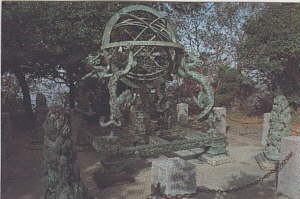
The Armillary
Sphere
Made in the 4th year during the reign of
Zhengtong (1439 AD) of the Ming Dynasty and designed for
the coordination of celestial bodies. Originally kept in
Beijing, it was moved to the Purple Mountain Observatory
in Nanjing, Jiangsu Province in 1931.

The Celestial
Globe
Made in 1673 AD(Qing Dynasty) and designed for
measuring the time and azimuth of the rising and setting
of celestial bodies, as well as measuring altitudes and
azimuths of celestial bodies at any time.
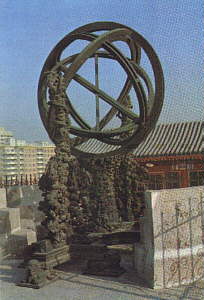
The New Armilla
Made in 1744 AD (Qing Dynasty) and designed
primarily for measuring true solar time as well as right
ascension difference and declination of celestial bodies.

The Equatorial
Armilla
Made in 1673 AD (Qing Dynasty) and designed primarily for
measuring true solar time as well as right ascension
difference and declination of celestial bodies.

The Abridged
Armilla
Made in the 4th year of the Zhengtong reign (1439 AD), it
is simpler than the Armillary Sphere in both structure
and operation. It was moved to the Purple Mountain
Observation in Nanjing at 1931.

The Altazimuth
Made in 1673 AD and designed primarily for measuring
azimuths of celestial bodies.
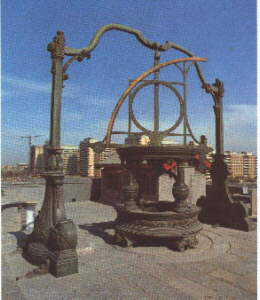
The Azimuth
Theodolite
Made in 1715 AD (Qing Dynasty) and designed primarily for
measuring azimuths and altitudes of celestial bodies.
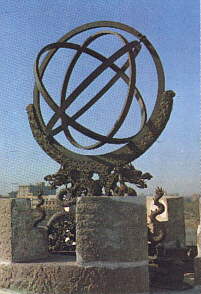
The Ecliptic
Armilla
Made in 1673 AD (Qing Dynasty) and designed primarily for
measuring ecliptic longitude difference and latitudes of
celestial bodies as well as the 24 Solar Terms.
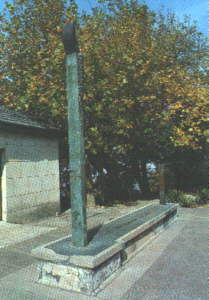
The Gnomon of
the Ming Dynasty
Made between the 2nd year and the 7th year of the
Zhengtong reign (1437-1442) of the Ming Dynasty and
designed for determining the length of a tropical year
and the 24 Solar Terms.

The Quadrant
Made in 1673 AD and designed for measuring altitudes or
zenith distances of celestial bodies.
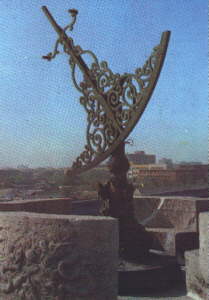
The Sextant
Made in 1637 AD (Qing Dynasty) and designed for measuring
the angular distance less than 60 degree between any two
stars as well as the angular diameter of the sun and the
moon.
 |
|
|
|
|
|
|
|
Report:
Ancient Beijing Observatory |
Beijing's
ancient observatory offers look at early astronomical
instruments - By Angela Pruszenski
Tucked behind the southwest exit of the Jianguomen subway
station, Beijing's Ancient Observatory is an unexpected
break from the surrounding modern towers and hotels. The
observatory was once a research center for some of the Ming
and Qing dynasties' most important scholars.
Built in the year 1442 during the Ming Dynasty, the
observatory offers unique insight into ancient scientific
techniques. Research at the observatory ceased in 1929 but
achieved a world record for 487 years of continuous
astronomical observation.
But astronomical research in China dates back even further.
In 1279, the Chinese astronomers WangXun and Guo Shoujing
built a small observatory just north of where the Ancient
Observatory stands today. During the Song Dynasty
(960-1279), astronomers created a catalogue of 1848 stars
and 283 constellations. Some astronomical records date back
to the Han Dynasty (206 BCE-220 CE).
Astronomy and astrology have historically played a role in
emperors' decisions and planning.
The ancient Chinese believed there was a relationship
between the sky and earth, and that observations in the sky
could predict wars and accidents, according to Xiao Jun,
Deputy Director of the Beijing Ancient Observatory. As a
result, astronomical research was relegated to upper-class
scholars and selected foreign missionaries, and the
observatory was not open to the public.
New emperors often ordered a new calendar to be made.
Releasing a more accurate calendar was a sign that the new
emperor was truly sanctioned by the heavens. More than 100
calendars were produced starting in the Qing Dynasty.
"At first, the calendar was based on the lunar orbit, but
this was not suitable for farming, so the solar orbit was
added to the calendar," Xiao Jun said. "The lunisolar
calendar helped farmers plan their crops."
The year was divided into 24 solar terms which predicted the
changing of the seasons. In 1281, astronomer Guo Shoujing
calculated that one year was 365.2425 days, 300 years before
western astronomers made the same discovery and created the
Gregorian calendar. The lunisolar calendar system was used
until 1911 when the western solar calendar was adopted.
In addition to tracking movements in the sky, astronomers
also tracked the wind, rain and snow, making their practice
a combination of astronomy, astrology, and meteorology.
From 1669 to 1674, Emperor Kangxi commissioned Ferdinand
Verbiest to design six astronomical instruments, a celestial
globe, the equatorial armillary sphere, the ecliptic
armillary, the quadrant, the altazimuth and the sextant. In
1715, Killian Stumpf designed the azimuth theodolite, which
is a combination of an altazimuth and quadrant and is used
to measure the vertical and horizontal angles and altitudes
of celestial bodies. In 1744, Emperor Qianlong ordered the
construction of the last astronomical instrument -- the new
armillary sphere -- to be added to the ancient observatory.
These instruments occupied the roof of the observatory,
while the older instruments were moved to the yard below.
All of the observatory's instruments except the altazimuth
theodolite are adorned with bronze dragons at the base,
signifying that astronomy was a special discipline for the
emperor. A telescope was never added to the collection,
although the emperor acquired one and kept it at the palace
for personal use. The observatory was raided in 1900 during
the Eight-Nation Alliance's siege of Beijing, and the
instruments were taken by foreign troops. The French
returned five of the instruments the next year, while the
Germans took five of them to Europe to display at Potsdam
Hall. They were finally returned in 1921. Several of the
instruments were sent to Nanjing for safekeeping after the
Japanese invaded China.
The museum was opened to the public in 1983. Operated in
conjunction with the Beijing Planetarium, the Ancient
Observatory now receives about 500 visitors per week. There
are detailed English descriptions available. In the
courtyards surrounding the Ancient Observatory, there are
three exhibitions about the history of astronomy in China,
the uses of the various instruments and examples of ancient
instruments such as water clocks and sundials. Visitors can
also climb to the top of the observatory, which has 99 steps
to signify a relationship to the emperor. There they can
look at additional instruments displayed on the roof.
To learn about China's history with the stars, which mixed
astrology and superstition with astronomy and science,
visitors can spend an hour or two perusing the exhibits and
examining the instruments. Like many of China's more
treasured relics, the instruments have been well kept,
offering visitors an opportunity to examine ancient science
up close.
The Logistics:
Address: No. 2 Dongbiaobei Hutong, Beijing China
Transportation: Jianguomen subway station on line 1 or line
2, exit C. The museum is directly behind the subway station.
(Source: China Radio International) |
|
|
|
ADVERTISEMENT
 |
|
|
Related Links:
Ancient Beijing Observatory |
|
|
|
|
